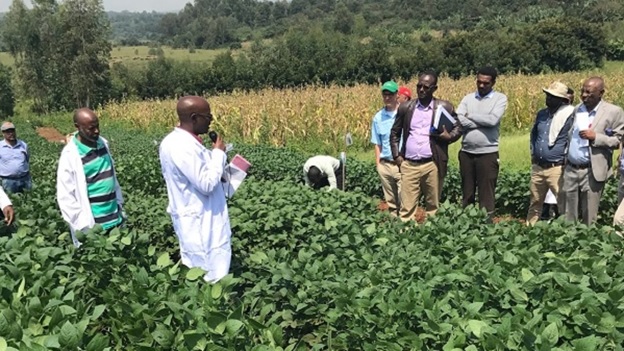
Food science professionals agricultural researchers say that soybean is a grain legume that is very nutritious and contains on average 40 percent protein. It is gaining ground internationally due to its multiuse use as human food, livestock feed, manufacturing purposes, and more recently, as a source of bio-energy.
Moreover, soybean contains 20 percent non-cholesterol oil and its fortified foodstuffs are considerably low-priced than other sources of high-quality protein. It very well may be utilized directly for nourishment in the family unit or handled for soy milk, cooking oil and a scope of different items including newborn child weaning sustenance. Also, the poultry sector industry uses soybean for feed production.
Ethiopian Institutes of Agricultural Research, Jimma Agricultural Research, National lowland oil crops research said soybean is becoming economical important oil crop in Ethiopia. The process of plant growth and development is important to the successful adaptation of a species to its geographic and climatic environment.
Evaluating the adaptability of released soybean varieties in diverse agro-ecology is important for efficient use of nationally released varieties in their area of adaptation and thereby increases production and productivity of soybean in the country. The trial was conducted with 19 released soybean varieties in the year 2015 and 2016 main cropping season at Jimma, South Western parts of Ethiopia.
The parameters collected include; days to flowering, days to maturity, number of pod per plant, number of seed per plant, hundred seed weight, rust ,common bacterial blight, lodging score and grain yield.
Moreover, Ethiopian Journal of Science and Technology in its “ Effects of processing methods on nutritional composition of improved soybean varieties for soymilk production by Demelash Hailu Mitiku from Jimma University said that soybean belongs to family Fabaceae. It is native to China and is one of the oldest world crops. It is widely grown in tropical and temperate regions of the world.
To date, the main attention of many research initiatives was to develop varieties that are high yielding, early maturing and tolerant to disease and drought. Soybean has been used in different food applications in the recipe of some infant foods in Ethiopia. One of the evidences could be efforts made by the Faffa Company in Ethiopia which has been working on the production of different soy products as a soy-fortified complementary food since 2003 and has become the first in the country to produce powdered soymilk, it said.
In addition to other food products, soybean is known to be among the major legumes that have been used in vegetable milk production. In line with this, efforts were made to use soybean in the processing of soymilk at small-scale farming level by women entrepreneurs in Ethiopia under the support of agricultural research centers.
These efforts were aimed at enhancing the use of soybean in the daily food of the households. Soymilk is used as vegetable alternatives to dairy milk in the formulation of infant foods because they have high protein, minerals and vitamins . Soymilk resembles cow’s milk in appearance and it is nutritionally comparable with the human and cow’s milk and hence can be comfortably used in place of cow’s milk in some recipes.
Therefore, it is considered as important healthy drink for people who are allergic to cow’s milk proteins or have lactose intolerance and those who have special health or religious diet requirements. Soymilk is also a rich source of soluble and insoluble dietary fibers, and isoflavones whose presence in everyday diet is very important, it said.
On the other hand, extensive consumption of soymilk is constrained by a number of factors related to the inherent constituents of soybeans including “beany” taste causing compounds and antinutritional factors that can reduce nutrient bioavailability. The main factor which hampers utilization of soymilk is the “beany flavor” that results from lipoxygenase-catalyzed reaction of polyunsaturated lipids especially linoleic acid producing products such as aldehydes, ketones and alcohols.
Other important demerits to the acceptability of soymilk are the astringency (throat catching factor) of soymilk which is related with flavor sensation. This sensation results from the interaction of polyphenolic substances present in soymilk with mucoproteins in the mouth and throat.
Different methods have been used to overcome the problem of off-flavor in soymilk using herbal additives in different parts of the world including Ethiopia. Proper processing of soybean into soymilk is important to suppress undesirable properties. However, in some conditions thermal processing detrimentally affects nutritional and quality attributes of soymilk and produces strong off-flavors. Blanching and soaking of the beans in water are among the remedial actions to overcome the negative effect of inherent components of soybean.
Despite the potential of soybean for improving food and nutrition security, and its importance for income generation through sale and employment opportunities in soymilk processing sectors, little information is available in the literature about the types of soybean varieties and processing methods that can produce soymilk with superior nutritional quality.
Moreover, soymilk processing and consumption in Ethiopia is not common. Processing at cottage or industrial scale is uncommon in Ethiopia. With this gap of information, this study was conducted to evaluate the effect of soybean varieties and processing methods on nutritional composition and mineral contents of soymilk.
Food insecurity and malnutrition are among the urgent difficulties that creating nations confront nowadays. The significant staple food harvest of most creating Sub-Saharan African Nations, maize, contains low protein. The difficulties are particularly intense in Ethiopia and relatively more serious in the rural than urban areas, primarily due to low level of understanding of a balanced diet and absence of ability to buy animal source proteins.
Producing and consuming more soy would enhance the circumstance (Food Security) as soy gives a nutritious mix of both calorie and protein consumption: it is the most nutritionally rich crop product, as its dry seed contains the highest protein and oil content among grain legumes with a good sense of balance of the essential amino acids and has 18-20 percent oil on a dry seed weight basis. It is discounted and rich source of protein for poor farmers, who have less access to animal source protein, because of their low acquiring limit
In this way, Soybean is an elective protein source to the rural families and can be utilized at home in different structures and the surplus can be sold to different buyers, producers and manufacturer for money. Many other products with a soya basis are also directly used for human consumption. In the major producing nations and especially in Brazil, Argentina, Paraguay and the USA soybean contributes fundamentally to the aggregate value added by the agricultural sector. In these nations, soybeans and its sub-products also occupy an important position in total export earnings. Among minor producers only India and Bolivia earn significant income from the exportation of soybean and derived products or by products.
BY ALAZAR SHIFERAW
The Ethiopian Herald 10 September 2021





